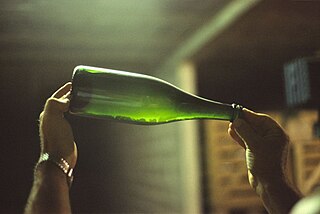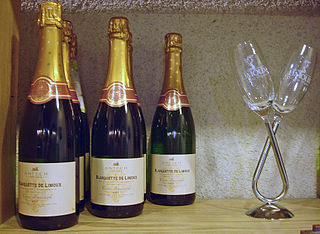
Champagne is a sparkling wine originated and produced in the Champagne wine region of France under the rules of the appellation, which demand specific vineyard practices, sourcing of grapes exclusively from designated places within it, specific grape-pressing methods and secondary fermentation of the wine in the bottle to cause carbonation.

Cork is an impermeable buoyant material. It is the phellem layer of bark tissue which is harvested for commercial use primarily from Quercus suber, which is native to southwest Europe and northwest Africa. Cork is composed of suberin, a hydrophobic substance. Because of its impermeable, buoyant, elastic, and fire retardant properties, it is used in a variety of products, the most common of which is wine stoppers.

Sparkling wine is a wine with significant levels of carbon dioxide in it, making it fizzy. While it is common to refer to this as champagne, European Union countries legally reserve that word for products exclusively produced in the Champagne region of France. Sparkling wine is usually either white or rosé, but there are examples of red sparkling wines such as the Italian Brachetto, Bonarda and Lambrusco, and the Australian sparkling Shiraz. The sweetness of sparkling wine can range from very dry brut styles to sweeter doux varieties.

A wine bottle is a bottle, generally a glass bottle, that is used for holding wine. Some wines are fermented in the bottle while others are bottled only after fermentation. Recently the bottle has become a standard unit of volume to describe sales in the wine industry, measuring 750 millilitres. Wine bottles are produced, however, in a variety of volumes and shapes.

Winemaking, wine-making, or vinification is the production of wine, starting with the selection of the fruit, its fermentation into alcohol, and the bottling of the finished liquid. The history of wine-making stretches over millennia. There is evidence that suggests that the earliest wine production took place in Georgia and Iran around 6000 to 5000 B.C. The science of wine and winemaking is known as oenology. A winemaker may also be called a vintner. The growing of grapes is viticulture and there are many varieties of grapes.

A bottle cap or bottle top is a closure for the top opening of a bottle. A cap is sometimes colorfully decorated with the logo of the brand of contents. Plastic caps are used for plastic bottles, while metal with plastic backing is used for glass; plastic caps are commonly made from polyethylene or polypropylene, while metal caps are usually either steel or aluminum. Plastic caps may have a pour spout. Flip-Top caps like Flapper closures provide controlled dispensing of dry products. Caps for plastic bottles are often made of a different type of plastic from the bottle.

Bottling lines are production lines that fill a liquid product, often a beverage, into bottles on a large scale. Many prepared foods are also bottled, such as sauces, syrups, marinades, oils and vinegars.
Wine accessories are things that may be used in the storage or serving of wine. Wine accessories include many items such as wine glasses, corkscrews, and wine racks.

Asti is a sparkling white Italian wine that is produced throughout southeastern Piedmont, but is particularly focused around the towns of Asti and Alba. Since 1993 the wine has been classified as a denominazione di origine controllata e garantita (DOCG) and as of 2004 was Italy's largest producing appellation. On an average vintage more than ten times as much Asti is produced in Piedmont than the more well-known Piedmontese red wine Barolo.
The glossary of wine terms lists the definitions of many general terms used within the wine industry. For terms specific to viticulture, winemaking, grape varieties, and wine tasting, see the topic specific list in the "See also" section below.

The traditional method is the process used in the Champagne region of France to produce Champagne. It is also the method used in various French regions to produce sparkling wines, in Spain to produce cava, in Portugal to produce Espumante and in Italy to produce Franciacorta. The method is known as the méthode champenoise, but the Champagne producers have successfully lobbied the European Union to restrict the use of that term within the EU only to wines produced in Champagne. Thus, wines from elsewhere cannot use the term "méthode champenoise" on products sold in the EU, and instead the term "traditional method" or the local language equivalent. South African wines from the Western Cape are labelled with the term Methode Cap Classique. Some wine producers in countries outside the EU may disregard EU labeling laws and use méthode champenoise or even "Champagne" on labels for products not exported to the EU, but this usage is decreasing.

Wine corks are a stopper used to seal wine bottles. They are typically made from cork, though synthetic materials can be used. Common alternative wine closures include screw caps and glass stoppers. 68 percent of all cork is produced for wine bottle stoppers.

Alternative wine closures are substitute closures used in the wine industry for sealing wine bottles in place of traditional cork closures. The emergence of these alternatives has grown in response to quality control efforts by winemakers to protect against "cork taint" caused by the presence of the chemical trichloroanisole (TCA).

Sabrage is a technique for opening a champagne bottle with a saber, used for ceremonial occasions. The wielder slides the saber along the body seam of the bottle to the lip to break the top of the neck away, leaving the neck of the bottle open and ready to pour. The force of the blade hitting the lip breaks the glass to separate the collar from the neck of the bottle. The cork and collar remain together after separating from the neck.

Sparkling wine production is the method of winemaking used to produce sparkling wine. The oldest known production of sparkling wine took place in 1531 with the ancestral method.

Limoux wine is produced around the city of Limoux in Languedoc in southwestern France. Limoux wine is produced under four Appellation d'origine contrôlée (AOC) designations: Blanquette de Limoux, Blanquette méthode ancestrale, Crémant de Limoux and Limoux, the first three of which are sparkling wines and dominate the production around Limoux. The main grape of the region is the Mauzac, locally known as Blanquette, followed by Chardonnay and Chenin blanc. In 2005, the Limoux AOC was created to include red wine production consisting of mostly Merlot. Wine historians believe that the world's first sparkling wine was produced in this region in 1531, by the monks at the abbey in Saint-Hilaire.

The history of Champagne began when the Romans planted vineyards in this region of northeast France in the 5th century, or possibly earlier. Over centuries, Champagne evolved from being a pale, pinkish still wine to a sparkling wine. When Hugh Capet was crowned King of France in 987 at the cathedral of Reims, he started a tradition that brought successive monarchs to the region—with the local wine being on prominent display at the coronation banquets. The early wine of the Champagne region was a pale, pinkish wine made from Pinot noir.
This glossary of winemaking terms lists some of terms and definitions involved in making wine, fruit wine, and mead.
Jacquesson & Fils is a Champagne producer based in the Dizy region of Champagne. The house was founded in Châlons-sur-Marne in 1798 by Memmie Jacquesson. The house makes the claim it is the oldest independent Champagne house.
Cava is a sparkling wine of denominación de origen (DO) status from Spain. It may be white (blanco) or rosé (rosado). The Macabeo, Parellada and Xarel·lo are the most popular and traditional grape varieties for producing cava. Chardonnay and Malvasia are also permitted. Authorized red grapes are Garnacha tinta, Monastrell, Trepat, and Pinot Noir. Only wines produced in the traditional method may be labelled "cava"; those produced by other processes may only be called "sparkling wines". About 95% of all cava is produced in the Penedès area in Catalonia, Spain, with the village of Sant Sadurní d'Anoia being home to many of the largest Catalan production houses. The two major producers are Codorníu and Freixenet. Cava is also produced in other villages in the provinces of Girona, Lleida, Tarragona, and Barcelona in Catalonia, Zaragoza in Aragon, Badajoz in Extremadura, La Rioja, Araba/Álava in the Basque Country, Navarra and València in the Valencian Community.
















